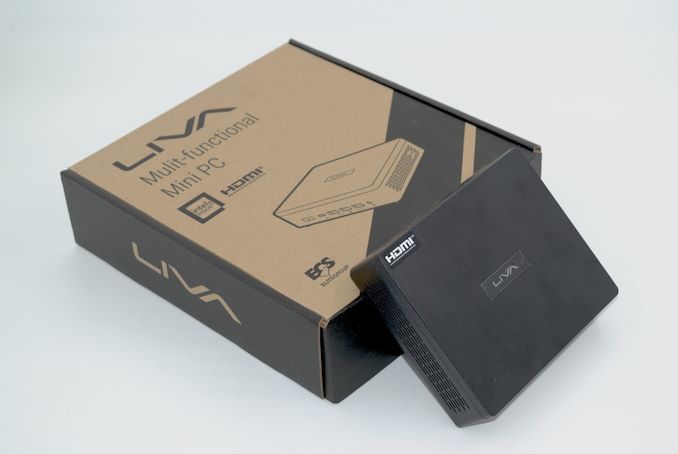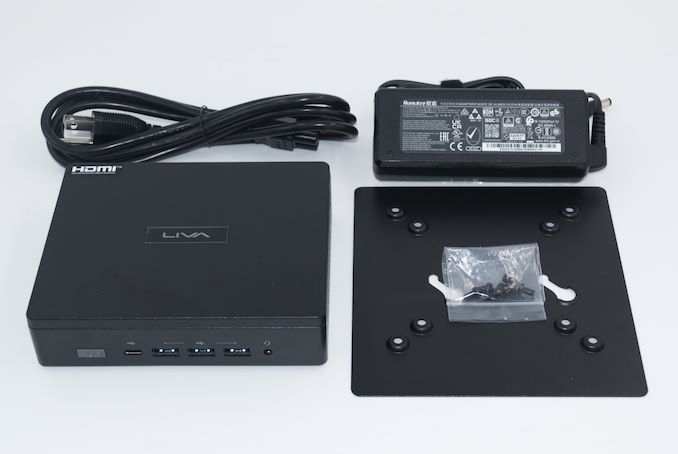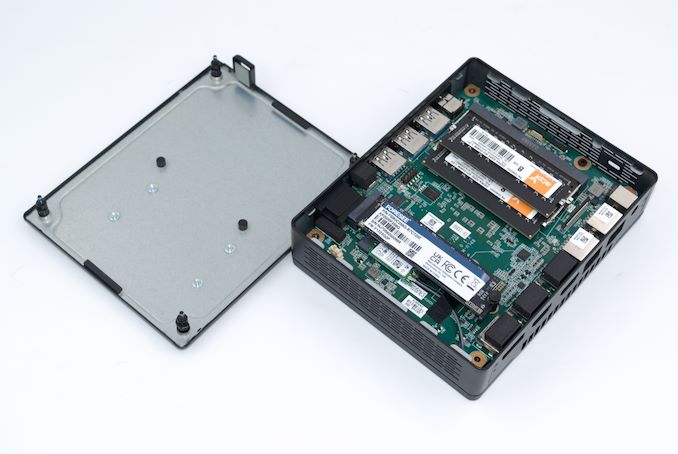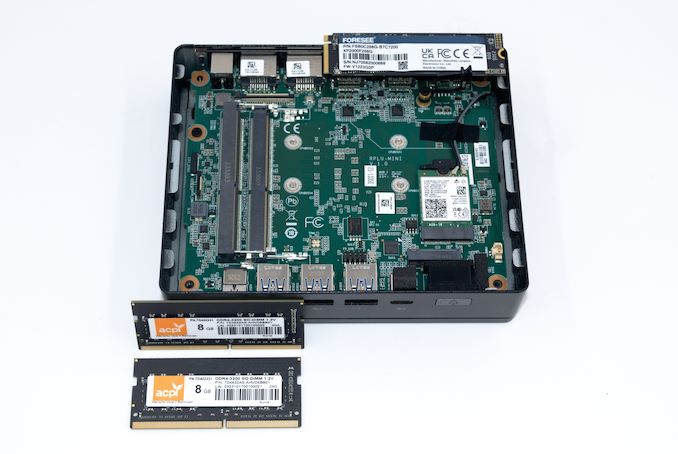ECS LIVA Z5 PLUS mini-PC Review: A Different Take on Raptor Lake
by Ganesh T S on August 2, 2024 8:45 AM EST- Posted in
- Systems
- ECS
- Mini-PC
- LIVA
- LIVA Z
- Raptor Lake
- Raptor Lake-U

The trend towards miniaturization of desktop systems was kickstarted by the Intel NUCs in the early 2010s. The increasing popularity of compact PCs also led to the introduction of a variety of slightly larger form-factors. Custom boards falling in size between the NUC's 4" x 4" ultra-compact form-factor (UCFF) and industrial-applications oriented 3.5" SBC have also gained traction. The ECS LIVA Z5 PLUS is one such system, designed and marketed towards business and industrial use-cases.
Intel's Raptor Lake series of products (based on a heterogeneous CPU architecture with both performance and efficiency cores) for the mobile market was introduced in early 2023. The P (28W) and U (15W) series were meant for mid-range notebooks and ultrabooks, with the H (45W) / HX (55W) series filling in for gaming and desktop replacement notebooks. Though the UCFF market started off with U series chips operating at 12W - 15W, the improvements in thermal design have enabled the cramming of processors with TDPs of 28W and higher in recent years. As a result, most mini-PCs using Raptor Lake opted for the P series SoCs. The ECS LIVA Z5 PLUS has a different take in the market - it adopts a U-series SoC with a slightly larger form-factor compared to the traditional NUC.
The review below provides a detailed look into the performance and features of the ECS LIVA Z5 PLUS. Prospective business customers have processor choices ranging from the RPL-U U300 to the Core i7-1365U. The reviewed system is a mid-range configuration with the Core i5-1335U. The benefits of ECS's cTDP-up setting, larger form-factor, and choice of I/O ports are also discussed.
Introduction and Product Impressions
The ECS LIVA Z5 PLUS is a 148mm x 120mm x 39mm mini-PC that lies somewhere between the traditional UCFF system and a 3.5" SBC in size. Similar to other recent LIVA systems, ECS is marketing this towards business and industrial users. The internal motherboard carries the RPLU-MINI tag. While the underside and casing are metal, the top cover is plastic (ostensibly for better WLAN performance). Despite the slightly larger size, ECS has opted to put all USB ports in the front along with the power button and the audio jack. There are two LAN ports in the rear in addition to three dedicated video outputs.
While most RPL-P mini-PCs opted to go with DDR5 SODIMMs, the LIVA Z5 PLUS comes with DDR4 SODIMM slots. However, the M.2 slot operates at Gen 4 speeds for the primary storage duties. This is complemented by a rich set of I/Os - two 2.5 GbE LAN ports, a full-featured USB4 port (with support for Thunderbolt peripherals), and three USB 3.2 Gen 2 Type-A ports.
The system package includes a VESA mount and associated screws. A 19V/4.74A 90W DC power adapter and a geo-specific power cord are also present.
Access to the SSD and RAM slots are via a removable panel on the underside kept in place with the aid of four screws.
Our review system came pre-installed with 2x 8GB DDR4-3200 SODIMMs and a PCIe 4.0 x4 DRAM-less NVMe drive. There was strangely no SSD thermal solution attached to the underside, though some markers are present to guide in placing thermal pads directly on top of the M.2 slot. The full specifications of the review sample are provided in the table below.
| ECS LIVA Z5 PLUS Specifications (as tested) |
|
| Processor | Intel Core i5-1335U Raptor Lake 2P + 8E / 12T, up to 4.6 GHz (P) up to 3.4 GHz (E) Intel 7, 12MB L2, Min / Max / Base TDP: 12W / 55W / 15W PL1 = 20W, PL2 = 39W |
| Memory | ACPI Digital 7D402331 DDR4-3200 SODIMM 22-22-22-52 @ 3200 MHz 2x8 GB |
| Graphics | Intel Iris Xe Graphics (80EU @ 1250 MHz) |
| Disk Drive(s) | FORESEE XP2000F256G (256 GB; M.2 2280 PCIe 4.0 x4 NVMe;) (Micron 176L 3D TLC; Silicon Motion SM2269XT Controller) |
| Networking | 2x 2.5 GbE RJ-45 (Intel 225-V) Intel Wi-Fi 6E AX211 (2x2 802.11ax - 2.4 Gbps) |
| Audio | Realtek ALC256 (3.5mm Headphone Jack in Front Panel) Digital Audio and Bitstreaming Support over HDMI and DisplayPort Outputs |
| Video | 2x HDMI 2.0a (Rear) 1x DisplayPort 1.4(Rear) 1x DisplayPort 1.4 (Front / USB4 Type-C) |
| Miscellaneous I/O Ports | 3x USB 3.2 Gen 2 Type-A (Front) 1x USB4 (up to 40 Gbps) Type-C (Front) |
| Operating System | Windows 11 Enterprise (22631.3593) |
| Pricing | $630 (as configured) |
| Full Specifications | ECS LIVA Z5 PLUS Specifications |
The FORESEE XP2000 is a SM2269XT-based SSD popular among OEMs. ACPI is a brand of Patriot Memory servicing OEM customer requirements.
In the next section, we take a look at the system setup and follow it up with a detailed platform analysis.













14 Comments
View All Comments
eastcoast_pete - Friday, August 2, 2024 - link
Appreciate the reviews of these compact systems. One remark about the intended use as an "industrial PC": for that, having an additional set (2) of USB 2.0 ports in addition to the USB 3 (A type) and the sole USB 4.0 would have made sense (and there's enough space for them, too). Reason: some peripherals just don't play well with USB 3, for whatever reason. Never mind what the USB standards body says, 100% backward compatibility is not always a given. If your equipment that you want to drive is a USB 2.0 device, it's safer to get something with at least one USB 2 Port.Oxford Guy - Friday, August 2, 2024 - link
'The power limits are conservatively configured at 20W / 39W, which is reasonable for an actively-cooled compact mini-PC targeting the industrial and business markets. It contributes to long-term product reliability.'I didn't see anything about a fan nor fan noise. Did I miss something?
powerarmour - Saturday, August 3, 2024 - link
Who would buy this now with Intel confidence in the toilet, that's the main issue.The_Assimilator - Saturday, August 3, 2024 - link
People who understand that embedded CPUs aren't affected.TheinsanegamerN - Monday, August 5, 2024 - link
*Yet.First it was only i9k,s, then i7 and i9ks, then all ks, then some xeons, then normal chips and T/F series started becoming unstable.
So how long you figure the mobile lineup has?
meacupla - Saturday, August 3, 2024 - link
A U-series i5 using DDR4 is probably unaffected. It's running well under the settings that cause degradation.TheinsanegamerN - Monday, August 5, 2024 - link
Xeons do to, and those have experienced the same failure.meacupla - Monday, August 5, 2024 - link
Can you point to link of Xeon failing from the same problem as the 13/14gen desktop chips?Are you sure you're not mistaking it with the W680 workstation boards used as cheap servers?
Even at PL2, the U series 13th gen is well under the >65W setting that is part of the problem.
sharath.naik - Sunday, August 4, 2024 - link
I just bought a Thinkbook16 7530u for 500$. It has 2 ram slots and 2 SSD slots. Plus has keyboard/ display and battery. Not sure this makes any sense right now.PeachNCream - Sunday, August 4, 2024 - link
That's always been the trouble with the NUC and its clones. You get less computer compared to a laptop of similar price, less portability, and they aren't functional without external hardware. Barebones systems require additional internal hardware and an OS license. Upgrade options are identically limited. There are people to which they'd appeal, but I'd argue that in a fair number of those use cases, a laptop would have been a better choice even if the buyer doesn't feel as special during and after the purchase.